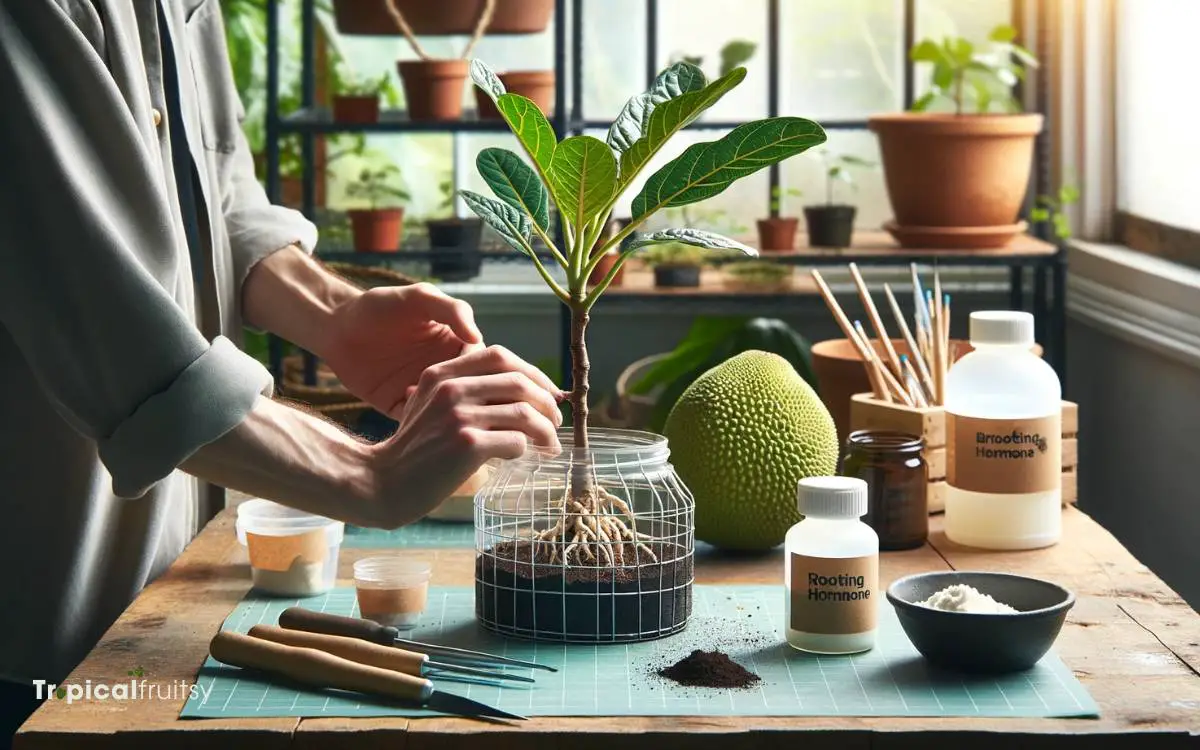How to Grow Breadfruit from Cutting? 5 Easy Steps!
Propagating breadfruit from cuttings is a viable technique to produce uniform and true-to-type trees.
The process involves selecting healthy cuttings, treating with rooting hormones, and planting in a suitable medium, followed by careful aftercare.
Here are some quick steps:
Successfully propagate breadfruit cuttings by focusing on optimal cutting health, medium preparation, and diligent aftercare.

Key Takeaway
Step 1: Selecting the Right Cutting

Choosing a healthy, disease-free cutting is crucial for successful breadfruit propagation. The cutting must originate from a vigorously growing branch of a mature, productive tree, ensuring the genetic potential for fruitful yield is preserved.
Ideally, the selected scion should be semi-hardwood, approximately 30-60 centimeters in length, and contain multiple leaf nodes from which roots can emerge.
The presence of pests, pathogens, or any form of necrosis on the cutting is a disqualifying factor, as these can compromise the cutting’s viability and the health of subsequent plantings.
It is imperative to inspect the cutting’s surface for uniform color and texture, indicative of robust health.
A meticulously chosen cutting significantly increases the likelihood of successful rooting and, ultimately, a thriving breadfruit tree.
Step 2: Preparing the Cutting

Having selected an optimal cutting, the next step involves meticulously cleaning and trimming the specimen to promote effective rooting. Begin by rinsing the cutting with clean water to remove any dirt or debris.
Examine the bark for signs of disease or damage and excise any afflicted areas with a sterilized cutting tool to prevent infection and ensure a healthy growth process.
Trim the base of the cutting to create a fresh wound, which will enhance the absorption of water and nutrients.
This cut should be made at a 45-degree angle to maximize the surface area available for root development.
Carefully remove any leaves or side branches from the lower third to concentrate the cutting’s energy on root formation.
With the cutting appropriately prepared, the process now advances to the application of rooting hormone to further encourage root growth.
Step 3: Rooting Hormone Application

Apply a rooting hormone to the base of the breadfruit cutting to stimulate root initiation and growth.
The application of a rooting hormone, such as indole-3-butyric acid (IBA) or naphthaleneacetic acid (NAA), is critical to enhance the development of adventitious roots.
These synthetic auxins mimic natural plant hormones, promoting cell division and vascular tissue differentiation at the cut site.
Dip the basal end of the cutting approximately 1 to 2 inches into the hormone powder or solution, ensuring thorough coverage.
Excess hormone should be gently tapped off to prevent potential tissue damage from over-concentration.
The hormone-treated cutting should then be placed into a pre-prepared rooting medium. Optimal hormone concentration and exposure time vary, so refer to the rooting hormone’s specific instructions for best results.
Step 4: Planting Your Cutting

Upon completing the hormone treatment, carefully insert the breadfruit cutting into the center of a well-draining potting mix, ensuring it is stably positioned at an appropriate depth.
The cutting should be inserted deep enough to support itself, typically about a third of its length, but not so deep as to cause it to rot.
Firm the soil around the base to eliminate air pockets and provide support. Optimal soil temperature for root initiation ranges from 25 to 32 degrees Celsius.
A balance must be struck between moisture retention and drainage to prevent root rot; hence, a potting mix rich in organic matter with perlite or sand is recommended. Ensuring these conditions will promote successful root development.
Step 5: Aftercare and Maintenance

Once a breadfruit cutting is successfully planted, establishing a consistent watering schedule is crucial to ensure the cutting develops a strong root system and sustains healthy growth.
Pruning techniques must be applied with precision to promote proper air circulation and light penetration, which are vital for the maturation of the breadfruit plant.
The following sections will detail the specific methodologies for irrigation and pruning to maintain the vitality of breadfruit plants grown from cuttings.
Watering Schedule
Establishing a consistent watering schedule is crucial to ensure the healthy growth of your breadfruit cutting.
Adequate moisture is essential for the establishment of the root system, which in turn supports the overall vigor of the plant.
The following guidelines should be adhered to:
- Ensure the soil is consistently moist, but not waterlogged, to avoid root rot.
- During the initial growth phase, water the cutting deeply once or twice a week, depending on weather conditions.
- Reduce the frequency of watering as the cutting matures and the root system becomes well-established.
The appropriate balance of moisture retention and drainage is vital for the cutting’s development. As the breadfruit plant progresses in growth, attention to pruning techniques becomes equally important to maintain plant health and productivity.
Pruning Techniques
Transitioning from the foundational care of watering, proper pruning represents a critical aspect of aftercare that ensures the breadfruit plant’s optimal health and productivity.
Precise cuts are necessary to remove dead or diseased wood, thin out dense areas to facilitate light penetration and air circulation, and shape the tree for structural integrity.
Pruning should be performed using sterile, sharp tools to make clean cuts that heal rapidly, thus minimizing stress and potential sites for infection.
Strategic removal of select branches should be executed to encourage fruiting and maintain a manageable tree size.
Timing is also essential, with the best period for pruning typically being the dormant season to avoid sap flow that could attract pests.
With the framework established for robust growth, we now turn to troubleshooting common issues that may arise.
Can I Use Breadfruit Flour to Grow Breadfruit from Cutting?
Yes, you can use breadfruit flour to grow breadfruit from cutting. The breadfruit flour making process involves drying and grinding the breadfruit into a fine powder, which can be used as a medium to plant and grow breadfruit cuttings. It provides essential nutrients for the cuttings to develop and thrive.
Troubleshooting Common Issues
Encountering challenges when propagating breadfruit from cuttings is common, but understanding these issues can lead to successful cultivation.
Key problems often arise from environmental factors, biological stressors, and improper care techniques. Addressing these effectively requires a methodical approach.
Consider the following common issues:
- Root Rot: Overwatering can lead to a soggy substrate, creating an anaerobic environment conducive to root decay.
- Pest Infestations: Cuttings are vulnerable to pests such as scale insects and mealybugs, which can impede growth by sapping vital nutrients.
- Fungal Diseases: High humidity without proper airflow can foster fungal pathogens, leading to diseases like leaf spot or blight.
Employing preventive measures and timely interventions is critical. Monitoring moisture levels, inspecting for pests, and ensuring good air circulation are indispensable practices for healthy breadfruit propagation from cuttings.
Conclusion
The cultivation of breadfruit from cuttings emerges as an arduous yet rewarding horticultural odyssey.
With meticulous selection and preparation of the cutting, coupled with the judicious application of rooting hormones, the nascent sapling is coaxed into existence. Subsequent aftercare and vigilant maintenance foster a verdant canopy, teeming with potential.
When common issues arise, they are swiftly addressed, ensuring that the breadfruit tree flourishes, an emblem of botanical perseverance and fecundity.






